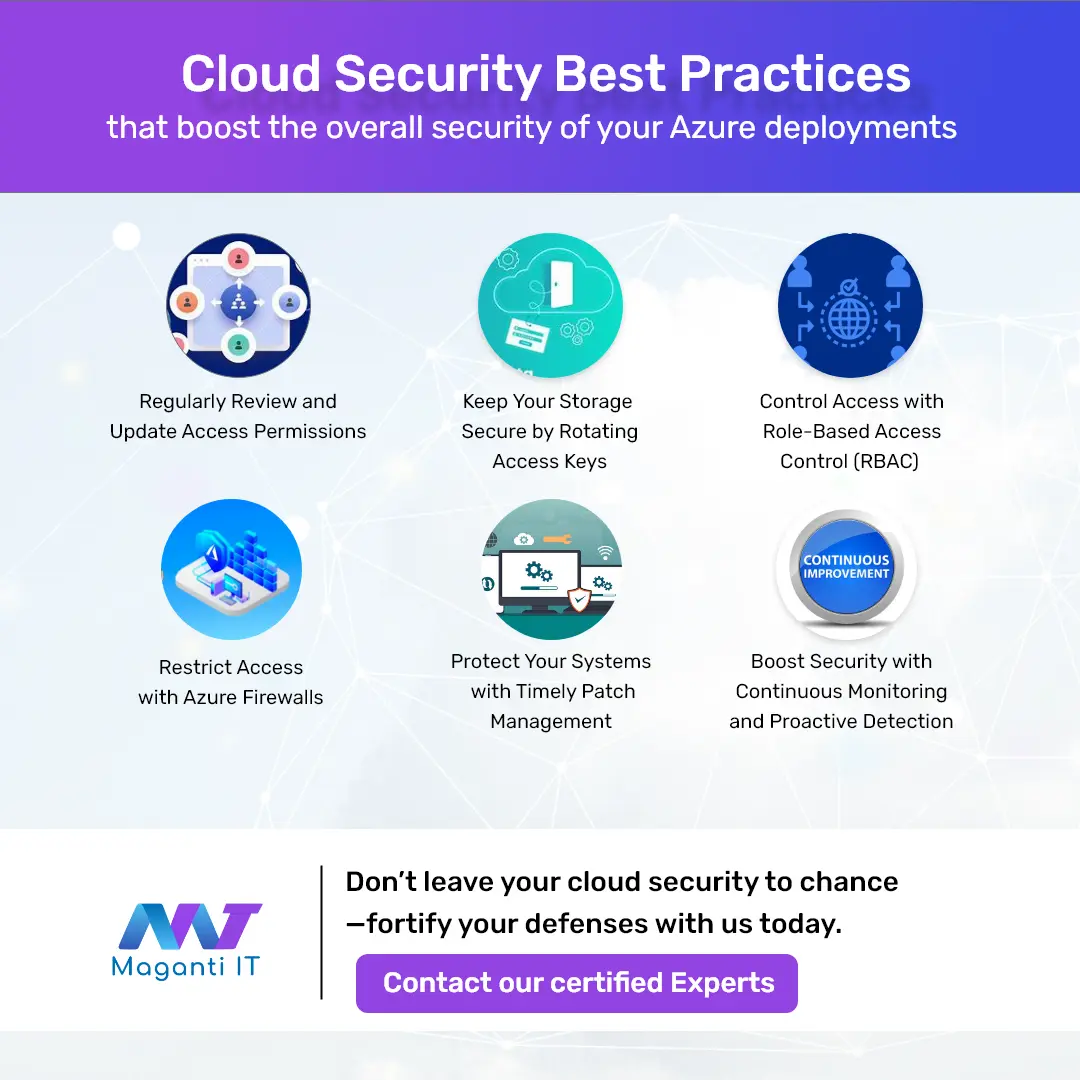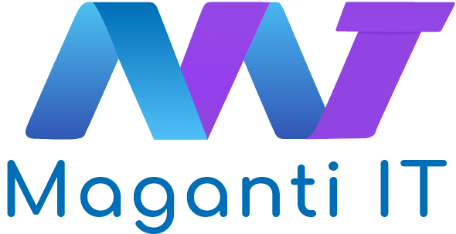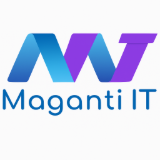the overall security of your Azure deployments
Introduction
- 1. Secure your data both at rest and in transit
- 2. Enable Multi-Factor Authentication
- 3. Implement Azure DDoS Protection
- 4. Maximize Security with Virtual Network Service Endpoints
- 5. Strengthen Your Security with Azure Security Center
- 6. Control Traffic with Network Security Groups (NSGs)
- 7. Enhance Security with Azure AD Conditional Access
- 8. Secure Credentials with Azure Managed Identities
- 9. Protect Your Data with Azure Storage Encryption
- 10. Regularly Review and Update Access Permissions
- 11. Keep Your Storage Secure by Rotating Access Keys
- 12. Control Access with Role-Based Access Control (RBAC)
- 13. Restrict Access with Azure Firewalls
- 14. Protect Your Systems with Timely Patch Management
- 15. Boost Security with Continuous Monitoring and Proactive Detection
- 16. Fortify Your Web App with Gateway Services
Cloud computing brings incredible benefits like better IT efficiency, flexibility, and scalability, but it also poses a big challenge: security.
Here are the top Azure Cloud security best practices that help keep your cloud environment safe from threats and vulnerabilities. By following these proven strategies from our certified cloud experts, you can protect your data, applications, and infrastructure on Azure. This not only reduces risks and ensures compliance with industry regulations but also boosts the overall security of your Azure deployments.

If an attacker gains access to your Azure SQL database, your data can still be protected by Transparent Data Encryption (TDE). This feature is available for Azure SQL, Synapse Analytics, and PostgreSQL. TDE ensures that your data remains secure by encrypting the database, backups, and transaction log files.
You have the option to manage the encryption key in two ways:
- Service-Managed Key: Azure manages the encryption key by default, providing a seamless and straightforward encryption solution.
- Customer-Managed Key: Alternatively, you can bring your own encryption key for greater control and customization of your security setup. This approach allows you to manage and rotate your encryption keys according to your security policies.
By implementing TDE, you add an essential layer of security to your Azure SQL databases, ensuring data protection even in the event of unauthorized access.
Multi-Factor Authentication (MFA) uses two or more verification methods: something you know (like a password), something you have (such as a security token or phone), or something you are (like a fingerprint or facial recognition). Enable MFA to boost your cybersecurity and provide crucial protection for your Azure environment.
Azure offers Distributed Denial of Service (DDoS) protection for your virtual networks. There are two tiers to choose from:
Basic Tier:Automatically enabled at no cost, this tier protects traffic to and from the Azure platform.
Standard Tier:This paid service requires manual activation and extends DDoS protection to resources within your virtual network, providing enhanced security against attacks.
These options let you select the right level of DDoS protection based on your specific security needs and operational requirements.
Restrict access to your Azure services within your virtual network to minimize entry points for malicious actors and block unauthorized external access.
This approach meets industry compliance standards, reduces threat exposure, and safeguards sensitive data, boosting your overall security.
Azure Security Center spots vulnerabilities in your Azure resources and suggests fixes. It offers unified security management and advanced threat protection, helping you monitor and respond to risks quickly. Using machine learning, it detects unusual behaviors like unexpected resource deployments or strange network activities.
When a threat is found, Azure Security Center generates a security alert detailing the threat, impacted resources, and suggested fixes. Promptly review these alerts, understand the threat, and follow the steps to resolve it. Keeping your resources up to date with patches is crucial to prevent vulnerabilities.
Enhance your threat response by integrating Azure Security Center with other services like Microsoft Sentinel for comprehensive threat management.
Azure Security Center comes in two tiers:
- Free Tier: Provides security monitoring and recommendations at no cost.
- Standard Tier: A paid subscription that extends coverage to hybrid environments, including on-premises and multi-cloud resources. Pricing depends on the number of resources monitored and features used.
Network Security Groups (NSGs) in Azure let you manage inbound and outbound traffic for network interfaces, virtual machines, and subnets. Acting as virtual firewalls, NSGs allow you to set rules based on protocols, IP addresses, ports, and traffic direction. This control helps prevent unauthorized access, secure applications, and mitigate threats like DDoS attacks.
Azure AD Conditional Access strengthens security and compliance by refining authentication without adding complexity for users. It acts as Microsoft's Zero Trust policy engine, evaluating various signals to enforce policies.
Traditionally, users enters a user ID and password, but attackers can compromise these credentials. To mitigate this risk, you should use multi-factor authentication (MFA), which requires an extra verification factor such as a code sent to a mobile device or a fingerprint scan. This approach ensures that only authorized users access sensitive resources, thereby enhancing overall security.
Azure managed identities ensure secure credential management via Azure Active Directory (Azure AD), reducing the risk of credential leaks. Azure generates and manages these credentials, keeping them secure and hidden from users and applications.
There are two types of managed identities:
- System-assigned managed identities: Azure automatically creates and manages these for resources like Virtual Machines (VMs) or Azure Functions, tied to the resource's lifecycle.
- User-assigned managed identities:Organizations create these standalone identities and assign them to multiple resources, offering flexibility in access control.
Using managed identities eliminates the need for manual credential handling, reducing the risk of exposure or misuse. Azure AD ensures that only authorized applications and services access resources, enhancing security and compliance.
Make sure your data in Azure Storage is encrypted at rest by using Server-Side Encryption (SSE). SSE automatically encrypts and decrypts your data, ensuring it stays secure without any extra effort on your part.

Over time, users might gain permissions they no longer need. Regularly reviewing and reducing these permissions is crucial to maintaining the principle of least privilege. Ignoring this practice can increase the risk of unauthorized access or accidental changes.
Regularly rotate and regenerate your storage account keys to enhance security. This practice helps manage access effectively and revoke permissions from former team members or collaborators, maintaining the integrity of your Azure Storage environment.
Implement Role-Based Access Control (RBAC) to ensure only authorized individuals can access specific Azure resources. This method offers a simple yet effective way to manage and enforce access permissions based on user roles in your Azure environment.
Enable firewalls for Azure services like SQL Database, Storage Accounts, and Key Vaults to restrict access. This setup allows only trusted IP addresses or selected virtual networks to connect, ensuring a more secure environment.
Effectively address security vulnerabilities by managing patches and remediating them promptly. Use Microsoft Defender for Cloud recommendations, perform regular vulnerability scans, and promptly apply patches and updates. This proactive approach significantly reduces risks from known vulnerabilities, ensuring your systems stay protected and resilient against potential threats.
Continuous monitoring and proactive threat detection are essential for Azure security. Tools like Microsoft Defender for Cloud, Azure Monitor, and Microsoft Sentinel provide comprehensive monitoring, logging, and advanced analytics to help organizations detect and respond to threats promptly.
Microsoft Defender for Cloud secures Azure resources against evolving threats. Azure Monitor collects and analyzes telemetry data to offer insights into system performance and security. Microsoft Sentinel uses AI and machine learning to detect suspicious activities and automate responses.
Together, these tools create a layered defense that strengthens your Azure security posture, ensuring quick threat management and safeguarding critical assets and data.
Deploy a gateway service like Azure Front Door or Application Gateway to filter incoming traffic and protect your web app from attacks. Enable the Web Application Firewall (WAF) in these services to block malicious traffic and generate detailed security reports. This layered approach strengthens your web app's defenses against cyber threats.
Protect your business from evolving cyber threats with our comprehensive cloud security services that Maganti IT offers. Whether you're using AWS, Azure, or Google Cloud, our expert team will customize a security solution that fits your unique needs. From continuous monitoring and threat detection to advanced threat mitigation, we ensure your data and applications are always safeguarded.
Contact us now for a free consultation


